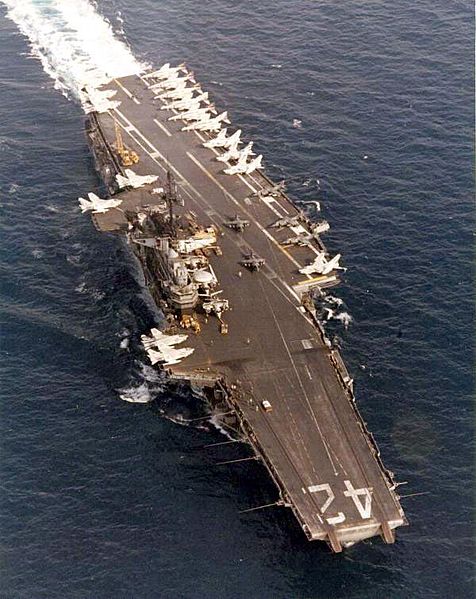 A E-2C Hawkeye on the flight deck of the USS Harry S. Truman, circa 2005. Each ship has a sponsor—a living woman, normally a civilian—who is considered a permanent member of the ship's crew, and is considered to bestow a part of her personality to the ship. Photograph by Phan Kristopher Wilson/DoD.
A E-2C Hawkeye on the flight deck of the USS Harry S. Truman, circa 2005. Each ship has a sponsor—a living woman, normally a civilian—who is considered a permanent member of the ship's crew, and is considered to bestow a part of her personality to the ship. Photograph by Phan Kristopher Wilson/DoD.
Last month, the U.S. Navy submitted a report to Congress outlining the policies and practices for naming Navy vessels. (The 82-page document provides a history of how the practice has evolved over time;
download a pdf of the report here.)
The report, prepared by the Department of the Navy staff, highlights the tensions between “orthodox traditionalists” (those who believe that Navy ship names should remain faithful to naming conventions), and “pragmatic traditionalists” (those who view orthodox traditionalists as too rigid). The two groups have been able to work together in the past, however. Consider this: By 1968, the only active ship named in honor of a U.S. state was the USS New Jersey, an Iowa-class battleship. With battleships no longer in production, the report notes, state names were chosen to be applied to nuclear-powered guided missile frigates, as it was expected that 25 would be built. But only six were manufactured; so in 1975, Secretary of the Navy J. William Middendorf decided that nuclear-powered strategic ballistic missile submarines should carry state names. “Consequently,” notes the report, “in the 1980s, the Navy’s battle force included three different types of ships in four different classes named for States of the Union.”
The USS Franklin D. Roosevelt in the Mediterranean Sea, circa 1977. Photograph by John Wilson, U.S. Navy.
Which brings us to carriers. The Navy’s first carrier (a converted collier),
the USSLangley, was named for aviation pioneer Samuel P. Langley,
the inventor of theAerodrome, and the third Secretary of the Smithsonian Institution. When the Navy was compelled to stop building battle cruisers after 1923, Secretary of the Navy Edwin Denby decided that new construction aircraft carriers (CVs) should be named after “historic Naval Vessels or battles” (think
Lexington,
Saratoga,
Ranger,
Yorktown,
Enterprise,
Wasp, and
Hornet). Once World War II began, the convention was modified to “famous old ships and important battles of our history and present world war”—and included
Independence-class light fleet carriers (CVLs).
During World War II, as the Navy began to acquire escort carriers, Secretary of the Navy Frank Knox decided to separate them from CVs and CVLs by naming them after “sounds, bays, and islands.” (This was later amended to “sounds, bays, islands, and famous American battles.”)
By VJ Day (August 14, 1945), all of the Navy’s 28 fleet carriers and 71 escort carriers—save one—followed their naming conventions. The exception was an aircraft carrier named Shangri-La, meant to memorialize the famous 1942 Doolittle Raid on Tokyo. (The report notes that “to protect the fact that the raid had been launched from an American aircraft carrier, President Roosevelt announced the attack had been launched from a new secret base at ‘Shangri-La,’ the fictional faraway land in James Hilton’s novel Lost Horizon.”)
As World War II concluded, carrier naming convention was again modified. After President Franklin D. Roosevelt’s death, Secretary of the Navy James Forrestal recommended to President Harry S. Truman that the second of the new Midway-class carriers be named in Roosevelt’s honor. It was the first time since the Langley that a carrier had been named after an individual.
In 1968, the USS John F. Kennedy was commissioned, and the orthodox traditionalist group recommended that future aircraft carrier names be considered on an individual basis. While carriers are now generally named in honor of past U.S. Presidents, some exceptions have been made, such as the USS Carl Vinson (in honor of Congressman Carl Vinson, known as “the father of the two-Ocean Navy”), and the USS John C. Stennis (named in honor of Senator John Stennis, and known as “the father of America’s modern Navy”).









Niciun comentariu:
Trimiteți un comentariu